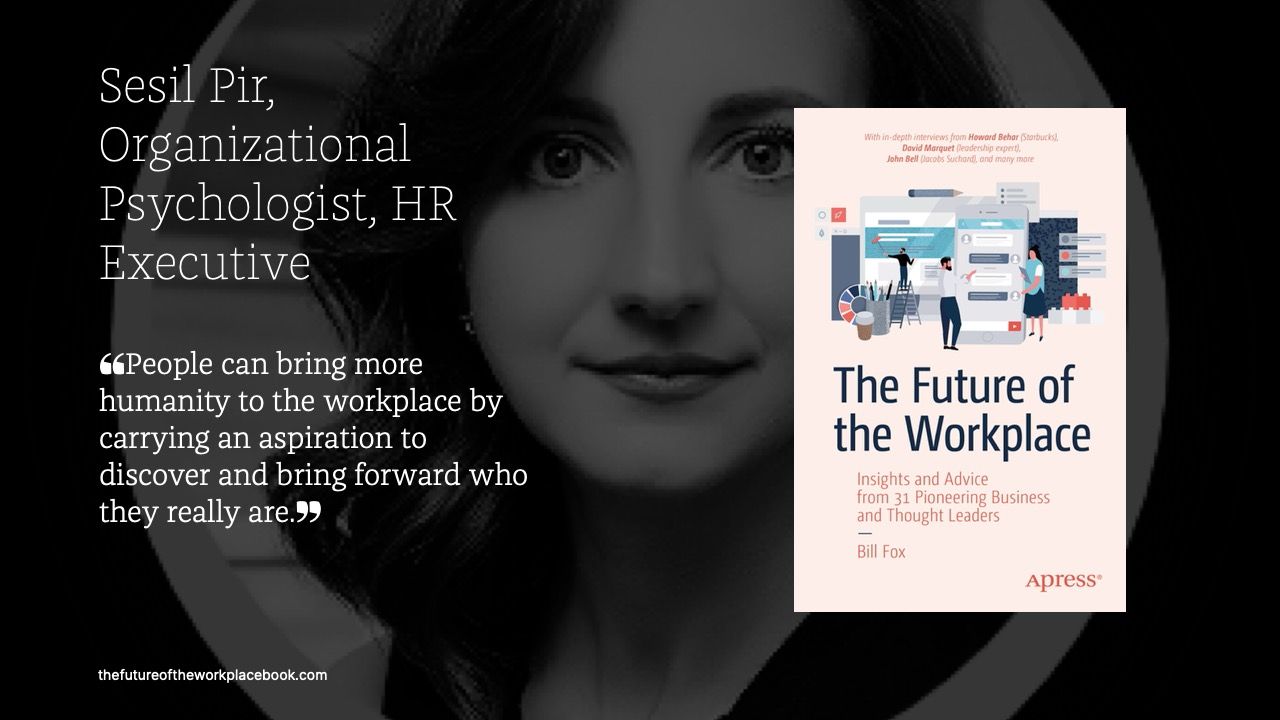Why Aren’t 21st-Century Employees Thriving?

Sesil Pir: I/O Psychologist, HR Executive, Leadership and Transformation Expert at Sisil Pir Consulting. Author of Human-Centered Leadership.
Forward Thinking Workplaces is a global narrative that's uncovering exciting new perspectives to help you succeed and be a forward-thinking leader and workplace in the 21st century.
Check out our upcoming Events page or visit billfox.co to learn more.
How can we create workplaces where every voice matters, everyone thrives and finds meaning, and change and innovation happen naturally?
Sesil Pir: That’s a lot to inquire about in one sentence, so I’d like to divide it into pieces. Where every voice matters. I think of that as everyone having a space to “be” as an individual. I associate that with respect and dignity.
Meaning, change, and innovation are different things. And I think someone’s thriving is potentially an outcome of many things.
Let’s look at “thriving.” I find two components that make up the language of someone’s thriving. The first component is often associated to vitality. It could be a sense of someone feeling alive, passionate, or even excited. It has a lot to do with having someone’s spirits uplifted. The second component relates to learning that comes from having a desire to continuously gain new knowledge and skills. When we think of a thriving workforce, I often think of it as one in which employees are not necessarily just satisfied. They’re productive and engaged in creating a better future for themselves and the overall organization. There’s somehow an intersection that brings in beauty and makes people thrive.
An employee who is thriving is productive and engaged in creating a better future for themselves and the overall organization.
I’m not so much for change for the sake of change. I believe in a transformative change, which comes with a valid reason for someone to participate in or to lead change. When it comes to driving successful transformative change, there are a number of things to consider, including
- A purpose that people can feel they can associate to
- Leadership role modeling along the way
- A way for employees to express their opinions and be part of the decision-making
- Outcome metrics that people can measure themselves against
If we look at innovation, what I find is that innovation is an outcome of a number of factors. The most powerful driver is having someone exercise what we would call wonder. It’s a sense of awe if you will and that requires a lot of presence from people.
In some ways, it’s not surprising that many organizations struggle with the concept of innovation because they’re so busy. They’re busy with many things and sometimes not related to their vision), and that’s a counterproductive thing for people to go through in the process of creation.
Creativity requires information taking, but then a lot of reflective time for people to digest and experience that sense of awe. That’s where creativity kicks in.
When people are going from one meeting to another or from one task to another with no time for breathers, they aren’t digesting the information. They’re not having enough reflective time to find themselves in that state of awe.
One thing we have to ask ourselves as leaders of 21st-century organizations and as organizational specialists: Why is that despite the vast amount of investment that’s been done over the years, organizations continue to struggle with levels of productivity and well-being in the workplace? According to the Organisation for Economic Cooperation and Development (OECD), productivity and well-being in the workplace have been trending down tremendously. We continue to invest more capital into our organizations. We’re investing in technology. In some cases, we are growing our organizations by getting in more resources. But why aren’t we getting any more productivity or any more health out of our workforce?
It’s a fact that 21st-century organizations are struggling for their existence, and I genuinely believe it’s not for a lack of a good idea or a product to manufacture. They have many ideas to remain competitive in the market. It’s because they don’t understand how to think of their structure, role, networks, and routines in the context of human evolution. They don’t understand human physiology, psychology, and spirituality well enough to be able to provide the environment and experience for them to thrive. That’s where the click is.
What does it take to get an employee’s full attention and best performance?
Sesil: First, I’ll give you my personal view; then we can have a professional answer around the performance.
As a psychologist and as a human being, I genuinely believe we all want to be seen, heard, and cared for. When you take those factors into the workplace, we also want recognition for our contribution.
To get someone’s full attention, you need to genuinely desire and be there for them. I know no other way.
For example, if I am in a restaurant with my husband when a service person comes to take our order, I try to look at them in the eye and connect before I respond. I want to recognize they are another living soul. They deserve every bit of respect and care and everything else that I seem to think I deserve for myself. I see us as equals. That’s very hard to do in our modern lives. I’m sure there are cases where I was also looking at my phone when someone came to the table to take our order. I don’t mean to say I’m a perfect human being. That’s not the point. It is a genuine struggle we share in our modern lives. If we commit to remaining mindful and conscious of our interaction with others, I think that’s the inspiration.
At an organizational level, there are several indicators of performance, and I see many struggles in this area. When we go into businesses, it could be a small organization of 100 people or it could be a multinational of 400,000 people; we associate performance with productivity. If you look at the dictionary for what performance is, it is something that’s associated to our ability to act on a particular function or task. It’s arguably correlated to productivity. Therefore, we assume if we have the knowledge, skills, and reward mechanisms in place, then we should be able to generate the desired outcomes. Unfortunately, linking productivity that closely to performance is a false association, and it falters from a scientific point of view. It undermines the inner and outer support factors required for someone to not only complete a task and potentially overreach it.
To reach a specific outcome, we have to be in a particular state of mind, body, and spirit.
That state differs from one person to another. Being busy doesn’t equate to effectiveness in the workplace. If you take it to the broader scheme, profits don’t equate to social impact either. There is another issue there that we need to tackle.
It invites in a challenge for leaders, too. They want a pill. They want a formula. Take this pill and suddenly we all become more productive. I wish it was that easy. What I can say is that there’s both an individual and an organization at play in achieving desired performance.
Individually, a mindset shift may help. First, to understand we are human. Second, to understand we are enough. And third, to feel at the core we are worth it. If you are in a mindset where you recognize your humanity, you know you’re enough. You feel you can belong and that you’re worthy. You feel recognition and appreciation for the value you bring. Then you can already put yourself in a thriving state where you can reach productivity.
Organizationally, there are several things we can do, including having a clear purpose for why someone has to do something. Giving people autonomy is also important—providing the space to do it and then coaching them to mastery. If they have to learn something new or different, or if they’ve done something well, to note that they have done so, so they can repeat it. In summary, having that purpose, autonomy, and mastery focus really helps. That’s my take on performance.
I also think we should remember that performance management from an organizational perspective is not to eliminate error or people. But rather the idea is to understand the situations in which we thrive individually and collectively. Then if there’s an unseen that has occurred, learn and grow from it from that point forward.
Note: This is a preview of the full interview. The complete interview was selected by Apress for publication and continues in The Future of the Workplace.
